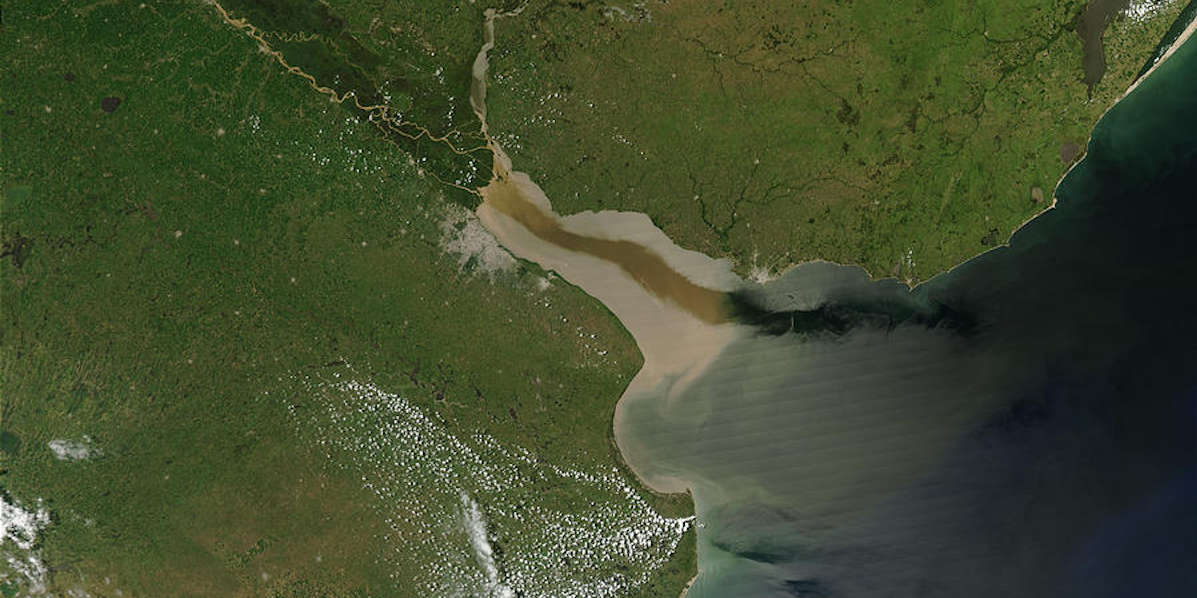In the picture
Satellite image of the Río de la Plata [NASA].
To access the interior of the Rio de la Plata, in order to reach the port of Buenos Aires or to enter the Paraná-Paraguay waterway, the main route for Argentine goods, ships must approach Montevideo, waiting in Uruguayan waters and paying Uruguay for the maritime services it provides. Planned years ago, Argentina is now preparing to open the Magdalena Canal, a corridor that aims to avoid Uruguayan waters, while at the same time lightening traffic, as it should allow navigation in both directions, unlike the current route. With this, Argentina seeks greater logistic autonomy; Uruguay estimates that it will lose hundreds of jobs.
The Río de la Plata is 325 kilometers long, from the confluence of the Paraná and Uruguay rivers to its final widening between Samborombón Bay, on the western shore, and Punta del Este, on the eastern shore. It acts as a natural border between Argentina and Uruguay and constitutes the main gateway to entrance and exit for Argentine trade.
Given the shallowness of much of the Rio de la Plata, the route that ships entering the estuary must take follows a central route, which is accessed transversely from the vicinity of Montevideo. From near the port of the Uruguayan capital, the ships take an artificial channel that runs from east to west, the Punta Indio, a hundred kilometers long, until it joins the Intermediate Channel (also known as Argentino), which is the main groove of the river bed. Due to its narrowness, the Punta Indio Channel is a one-way channel, which forces ships, especially those coming from the ocean, to wait for up to seven days. These waits, in waters of common use but administered by Uruguay, generate a business of some US$40,000 per day for those who provide the various port services in Montevideo (cargo transshipment, refueling and grocery supply, among others).
For some time, Argentina has wanted promote an alternative route, using the Magdalena Channel, a natural extension of the Intermediate Channel, aligned with the direction of the river current, which would allow entering the estuary navigating through Argentine waters, without touching Uruguayan jurisdiction. But it is a shallower channel, so that large vessels cannot use it to access the river ports of the Río de la Plata. For this reason, Argentina plans to adapt it for maritime traffic, dredging its bed to increase its depth from the current 4.5 meters to 11 meters and to reach a width of 150 meters, allowing navigation in both directions.
Although it goes back a long way, the project of the Magdalena Channel in its present formulation has its origins in 2002, when the Argentine Naval Prefecture (PNA) proposed the convenience of no longer postponing its implementation due to the progressive increase of cargo capacity in transoceanic transportation. In 2013, the government of Cristina Fernández de Kirchner took the initiative and began to take the necessary steps for its approval by the competent bodies, including the Comisión Administradora del Río de la Plata (CARP). The procedures were completed in January 2016, but the government of Mauricio Macri, who was then taking the initiative, decided to abandon the project due to its high cost.
With the return of Peronism to the presidency of the country, under the leadership of Alberto Fernández, and with the election of Axel Kicillof, a member of Kirchner's party, as governor of the province of Buenos Aires, the project was once again on the table. In the 2021 federal budget a multiannual item of 25.8 million pesos (about 300,000 dollars at the exchange rate at that time) was included for the beginning of works that could cost more than 300 million dollars. Once the environmental impact reports of project have been passed, it is now time to proceed with the international bidding process for its execution.


